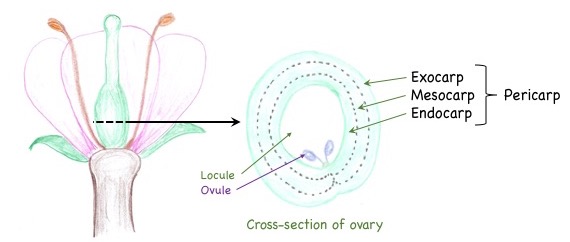
Fruit Types
In a flower, the ovary of the pistil becomes a fruit and the ovules inside it become seeds.
Gymnosperms (gymn="naked"; sperm="seed") have ovules (becoming seeds) that are not enclosed in an ovary. Therefore, they do not produce fruit.
Fruits sometimes protect seeds, sometimes help disperse seeds, and sometimes do both.
The fruit wall is called the pericarp. It has three layers: the exocarp, the mesocarp, and the endocarp.

Fruit types are classified, in part, based on how these layers develop. If all layers of the fruit wall are dry at maturity, the fruit is some type of dry fruit (dehiscent or indehiscent). If any of the pericarp layers are fleshy at maturity (i.e., still containing living fluid-filled cells with flexible walls after seeds have matured), they are considered a type of fleshy fruit. Fleshy fruits usually aid in seed dispersal by attracting animals that consume the fruit without (hopefully) harming the seeds.
In some cases, the "fruit" contains more than just the mature ovary of a pistil.
Inferior ovaries always have some other type of tissue fused to the outside of the ovary:

In some cases, most of the tissue that becomes fleshy and attractive to seed dispersers consists of other flower parts (sometimes the receptacle, sometimes petals and sepals, etc.).
Any tissue in a "fruit" that is not the pericarp (the ovary wall) is called accessory tissue.
Check your understanding:
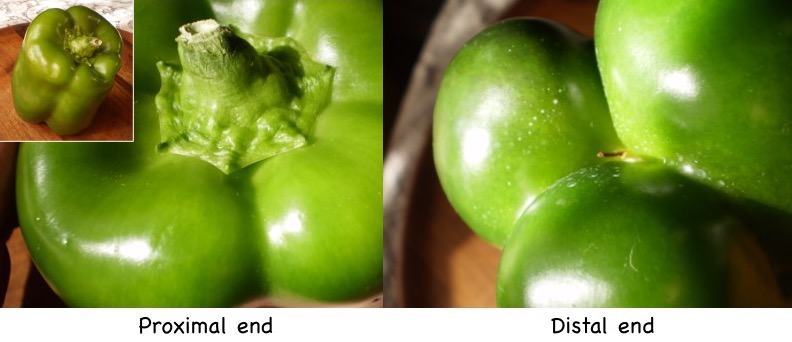
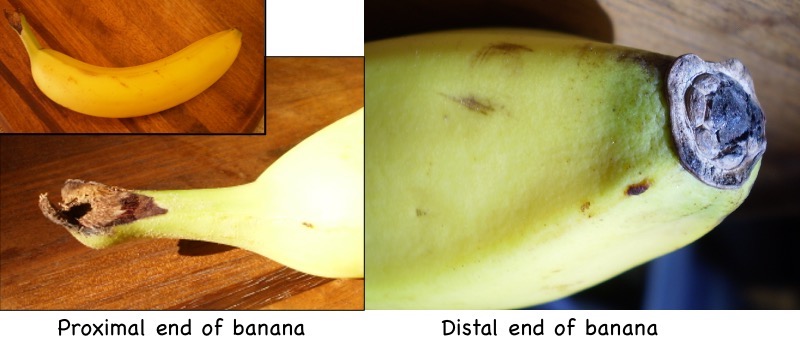
Simple fruits are fruits that develop from single ovaries.
These fruits may be considered fleshy fruits (as discussed earlier) or dry fruits.
Dry fruits may be indehiscent (not splitting open to release seed). These indehiscent fruits generally contain only one seed. In species with indehiscent fruits, entire fruits (or single-seeded sections of fruit) are dispersed from the plant, rather than individual seeds.
Dry fruits that split open to release their seeds are called dehiscent fruits.

There are several types of fleshy fruits, indehiscent dry fruits, and dehiscent dry fruits.
In fleshy fruits (fleshy simple fruits), one or more of the pericarp layers remains fleshy at maturity.
In a berry, all layers of the fruit wall are fleshy at maturity.

In a drupe, the exocarp and (especially) the mesocarp are fleshy, but the endocarp is hard (stony). These are sometimes called stone fruits. The "pits" in these fruits are not simply the seed; they are the stony endocarp that encloses the seed.
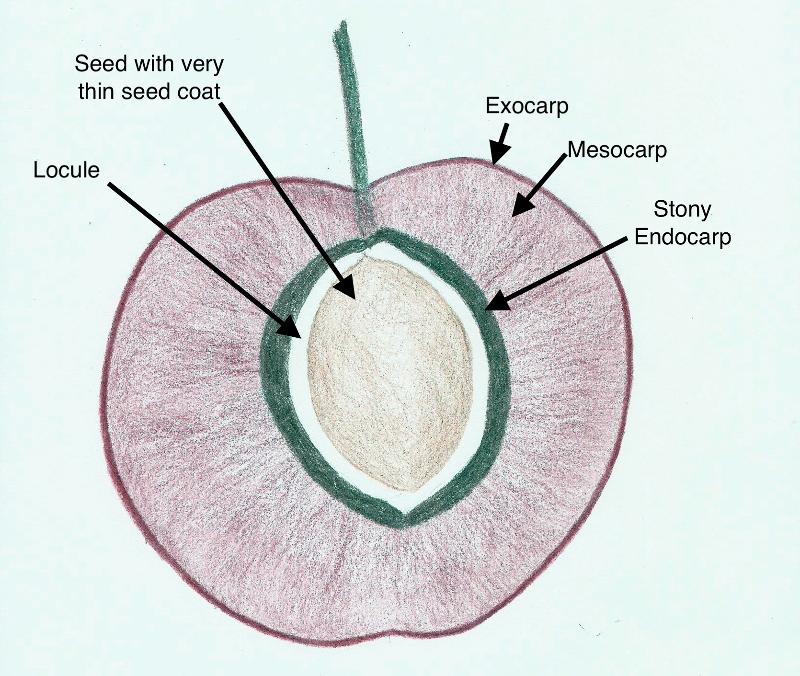
In a pome, the exocarp and mesocarp are fleshy, but most of the fruit's flesh is composed of other tissue (receptacle/hypanthium) that is fused to the outside of the ovary. This is not a common fruit type, but we do find it in the rose family (the Rosaceae): apples and pears are examples of pomes.
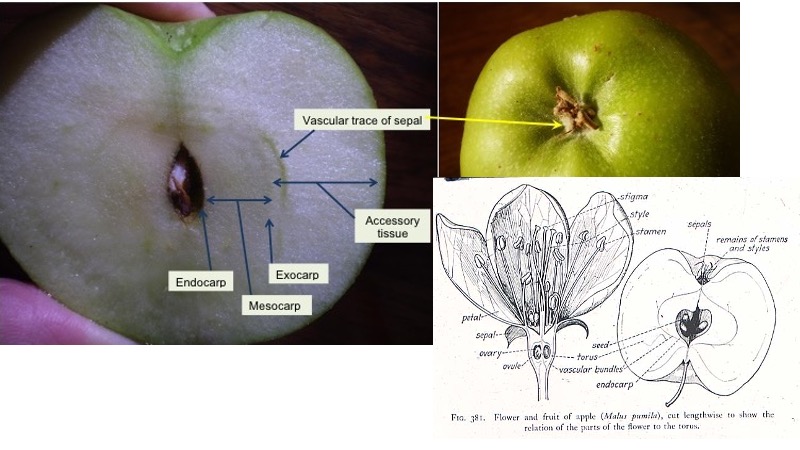
Other fleshy fruits, which you will not need to know for this class, include the pepo (a fleshy fruit from an inferior ovary in the Cucurbitaceae) and the hesperidium (a citrus fruit).
Dry indehiscent fruits include the caryopsis, the achene, the samara, and the "nut".
A caryopsis is an indehiscent fruit in which the seed coat is completely fused to the fruit wall. This fruit type is characteristic of the grass family and is commonly called a grain. A grain (caryopsis) is technically a one-seeded fruit, but you can't get the seed out of the fruit because they are fused together.
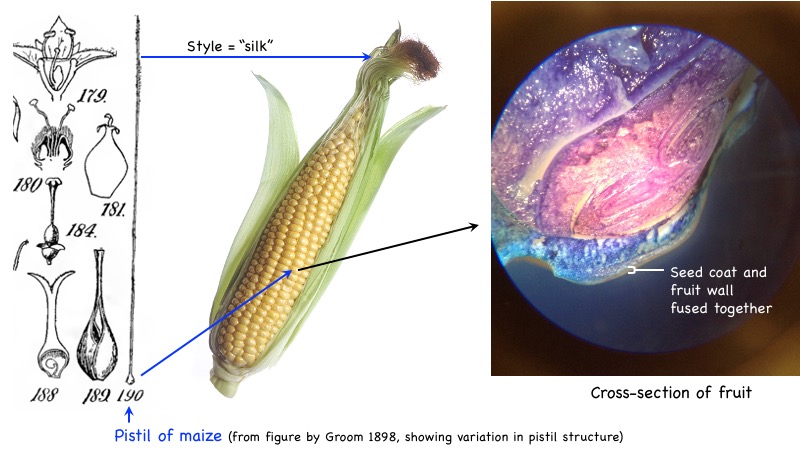
An achene is an indehiscent fruit in which the seed coat is NOT fused to the fruit wall. An example is the sunflower "seed": the shell of the sunflower "seed" is actually the fruit wall.
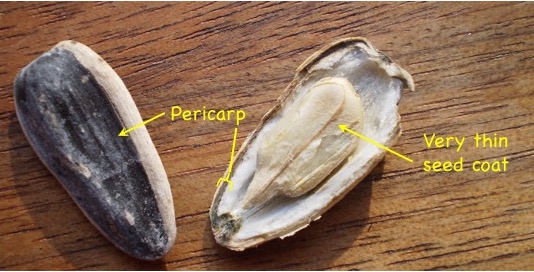
A samara is a winged fruit. (Seeds of some species may be winged, but samaras are winged fruits; they each contain a single seed.)

Some indehiscent fruits with very hard pericarps are called "nuts" (not shown).
A schizocarp is a fruit that separates into (usually) single-seeded segments at maturity. The schizocarp develops from the ovary of a single pistil with multiple, fused carpels. At maturity, however, fruit sections derived from different carpels separate from each other. These fruit sections are called mericarps. They are considered indehiscent because, although the fruit splits up, the fruit sections do not split open to release their seeds. Some members of the Malvaceae (the hibiscus family) and the Geraniaceae (the geranium family) have schizocarps.
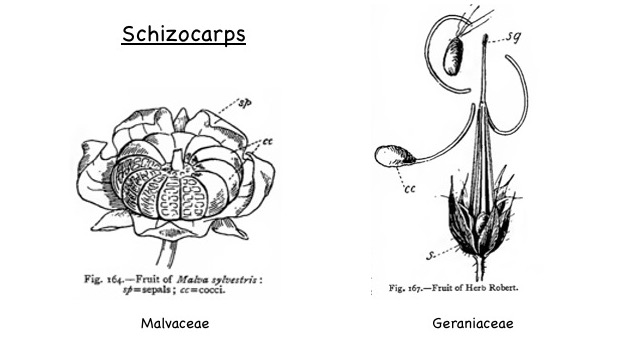
In a somewhat similar manner, lobes of deeply lobed ovaries may separate at maturity, with each lobe containing a single seed. These single-seeded structures are called nutlets. They are not considered schizocarps because the lobes on the ovaries (which become nutlets) do not represent separate carpels.

Check your understanding:
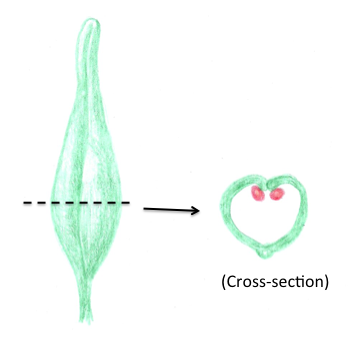 Two types of fruits are produced from ovaries that contain only one carpel.
Two types of fruits are produced from ovaries that contain only one carpel.
If the fruit splits along only one side, it is a follicle.
If it splits along two sides, it is a legume.
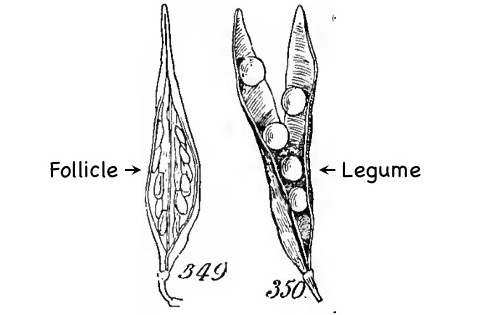
A silique is a fruit that is peculiar to the mustard family (the Brassicaceae). It comes from a pistil with two carpels and parietal placentation. However, a partition in the fruit joins the two placentae. When the fruit dehisces, the valves (the sections of the fruit wall) split away, leaving the seeds attached to the partition.
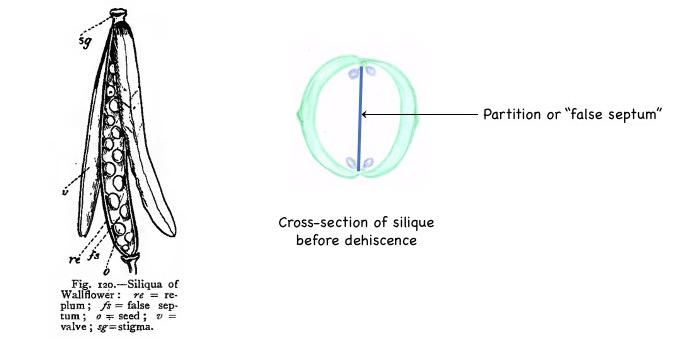
(A short silique is called a silicle.)
Dehiscent fruits from pistils with multiple carpels are generally called capsules. Capsules may split open in different places:

Check your understanding:
Three fruits are shown below:
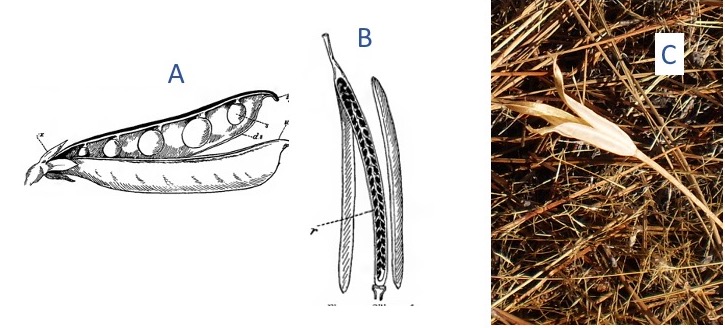
An aggregate fruit consists of multiple mature ovaries that are joined together. It develops from a single flower with multiple pistils:
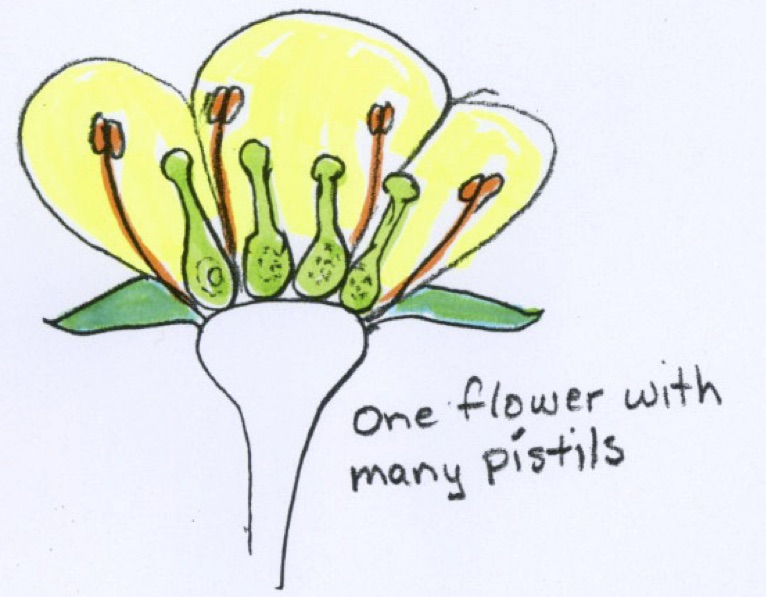
A raspberry is an example of an aggregate fruit. Each of the ovaries in the flower develop into a small drupe (or drupelet), but they stick together and fall off the plant as a single unit.

Check your understanding:
An accessory fruit is a fruit in which accessory tissue makes up most of the fruit. The accessory tissue is often (but not always) receptacle tissue. Some people refer to pomes as accessory fruits. A strawberry is another common example of an accessory fruit.
A strawberry (like the raspberry) comes from a flower with many pistils. In this case, however, the ovaries of the pistils turn into small achenes while the receptacle grows large, fleshy, sweet and red.

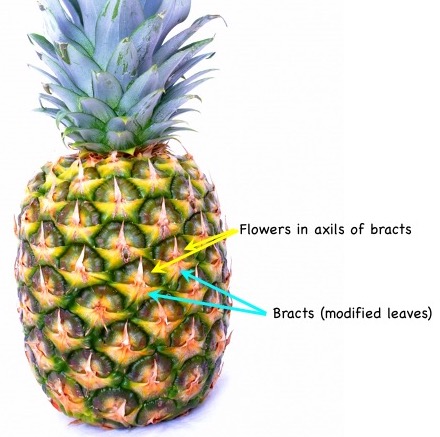 Multiple fruits come from multiple flowers. (Contrast simple fruits, which come from single ovaries, and aggregate fruits, which come from multiple ovaries in a single flower.)
Multiple fruits come from multiple flowers. (Contrast simple fruits, which come from single ovaries, and aggregate fruits, which come from multiple ovaries in a single flower.)
A pineapple is an example of a multiple fruit. It includes all of the ovaries in multiple flowers PLUS bases of petals, sepals, bracts between flowers, and the flowering stalk (stem) itself. Thus, there is a lot of accessory tissue in a multiple fruit.